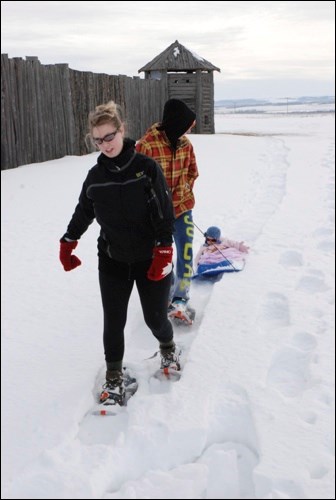When we think about winter travel today most of us think about our cars, trucks, buses and even possibly snowmobiles. But have you ever wondered how people on the Saskatchewan Prairies got around in winter before there were cars, or even proper roads?
The North West Mounted Police, the precursor of today's Royal Canadian Mounted Police necessitated travel in the harsh Prairie winters. First established in the West in 1873, their mandate in this region was to open up the land for settlement and aide the first settlers. Fort Livingstone was the NWMP's first headquarters.
Members of the NWMP were required to carry out their patrols even in winter, requiring other means of transportation besides horses. Like fur traders and explorers before them, they adopted two traditional aboriginal technologies: dogsleds and snowshoes.
The first known use of snowshoes dates as far back as 4000 BC, in Asia where they first realized that a foot-extending device made travel over snow much easier. Over time the use of snowshoes became a part of the cultural heritage of North America's Aboriginal people. Surprisingly, it was not those living in the Arctic who used snowshoes, but those people further south who considered snowshoes a winter necessity. Inuit people living in the Polar Regions did not need snowshoes as they travelled over the tundra's wind-packed snow. The Athabascan and Algonquin people in the south and east used the snowshoe extensively, modifying its pattern to suit weather conditions and their own cultural preferences, and allowing for hunting to occur year round.
When the first settlers arrived on the prairies, not all of them adopted aboriginal transport methods. However, the North West Mounted Police, like the European fur traders who came before them, saw the value in these aboriginal methods of transport. A Mountie on snowshoes, or even a dogsled, soon became a common sight.
The Inuit in the Canadian Arctic had long used dog sleds for transportation while trading, fishing and hunting. Dog sleds were commonly used by the NWMP from the 1870s, as their number of northern outposts grew. This form of travel was used to deliver mail, supplies and news between these outposts on a regular basis.
Today, both dog sledding and snowshoeing are favourite recreational pass times amongst Canadian families. While still being used for hunting and travelling in northern communities, these practises have also become sources of winter sport and entertainment for people across Canada.
To find out more about the history of dog sledding and snowshoeing in Canada please call 1-888-773-8888 or visit us online at www.parkscanada.gc.ca.




